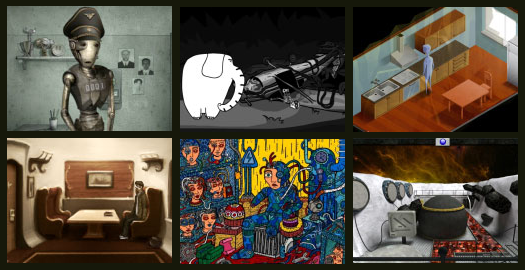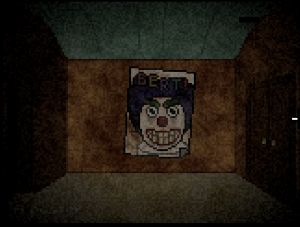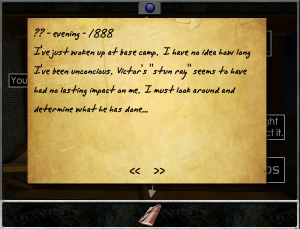Following Freeware: September 2013 releases

This month, you can become a cyborg trying to break out of a scientific facility or an android breaking into the dark recesses of an underground bunker. Explorers can try to find their way around a surreal house, delve into the deeper realms of their own sleeping minds or journey into fantastical pocket universes. Alternatively, you could take on such diverse goals as selecting a target to assassinate, rebuilding an elephant's beloved vacuum cleaner, or simply getting a drink on a disturbing overnight train. All these await you in this month’s roundup of releases from the freeware scene.
Postmortem
You are an Agent of Death. Your secretary gives you the assignment of going to a fundraising party and taking one life there. It doesn't matter who you kill, but you have to kill someone. She gives you the choice to go as a male or a female. So you choose your sex and go to the party, which is in Galicia, in the city of Antrim, on October 18th, 1893. As you talk to the guests you soon find out that the region is in turmoil and is on the brink of a civil war between the Newagers, who are mostly entrepreneurs from outside the area who build factories and make fancy new stuff, and the Oldagers, who are afraid the newcomers will change the things they love and the way they live so profoundly that they will lose their culture.
 In Postmortem, by Jakub Kasztalski, most of the action takes place inside the house of the Newager Bill Seldon, who gives the fundraising party there. You can move your character around in a 3D environment with the keyboard's WASD or arrow keys. A few other keys have specific actions assigned to them, like choosing a target to kill or interacting with a guest or an item. There are a few locked rooms which you can open once you have the keys to them in your possession. When you need an item that is in your possession, the game will use it automatically when you interact with the appropriate item or guest.
In Postmortem, by Jakub Kasztalski, most of the action takes place inside the house of the Newager Bill Seldon, who gives the fundraising party there. You can move your character around in a 3D environment with the keyboard's WASD or arrow keys. A few other keys have specific actions assigned to them, like choosing a target to kill or interacting with a guest or an item. There are a few locked rooms which you can open once you have the keys to them in your possession. When you need an item that is in your possession, the game will use it automatically when you interact with the appropriate item or guest.
The other guests also walk around in the house, so you can easily walk up to them and talk to them. When you talk to a character, his or her face is shown on the screen next to a voice bubble in which the character’s lines are shown above, with one or more possible answers you can choose underneath that. The answers can be chosen by pushing the corresponding number key. Only the first sentence of a conversation is spoken, with adequate voice acting. The environment and the characters are nicely drawn in a style that resembles the old Japanese children’s cartoons. All characters are easily recognizable by their features – their faces and the way they dress. An icon appears when you approach a character or an item with which you can interact. Classical music is played continuously in the background. You can set the volumes of all the noises, as well as the size of the window in which the game plays in the setup menu.
There are no real "puzzles" per se, but you find out a lot about the guests by talking to them and wandering around the house reading everything you can get your hands on. The characters are all very detailed; they have pasts, ideas about how to deal with the current political situation, and hopes and dreams for the future. They all talk freely to you about what is on their minds and usually give you honest answers to everything you ask. What makes this game unique is that you can try to convince people to change their minds about certain issues or take certain steps to improve their lives. You can even ask people what they think about each other. In fact, you can choose which role you play. Will you stay neutral, take a side or even wreak havoc amongst the guests and their relations with one other? Choosing who to kill then turns out to be a quite difficult task, as it decides the future of the community. The game also has an online feature that shows you how your choice compares to others.
Postmortem can be downloaded from the developer's website. There is an option to pay for an Extended Scythe Cut, which includes (amongst other things), an extra character and old 16-bit character sprites.
Deeper Sleep
Deeper Sleep is the sequel to scriptwelder’s Deep Sleep. In short, it’s a first-person 2D point-and-click horror adventure where you play someone trying to make sense of what is only a dream and what is reality. This game continues its predecessor's story, beginning with the protagonist looking for information concerning the nature of lucid dreaming. Of course, the only way to do this is to study up, so Deeper Sleep begins with searching for material at the local library. There, what at first seems real quickly transforms into another terrifying nightmare as the building shifts and you find yourself trying to escape from a deserted manor.
 This game deliberately looks older than it is, incorporating a crosshair cursor and pixelated graphics to invoke the adventure design of the early '90s. The retro look and film-grain effect is used to make you feel vulnerable, as if you are constantly looking into the unknown. The game plays with the visuals further by darkening rooms and decreasing colour contrast. There are a range of motifs used which naturally link to disturbing material such as empty children’s rooms with unused toys, dead animals hanging from the walls, and paintings of clowns which shift from cheery demeanours to angry ones. When the game begins, it issues an instruction to wear headphones and to play the game in the dark. Often you can only hear your own footsteps, but at times this is coupled with things that sound like they are moving in other rooms, making you wonder who is making the noise and whether it is a friend or foe. Likewise, music is scarcely used, but when it is it’s a disturbing orchestral score.
This game deliberately looks older than it is, incorporating a crosshair cursor and pixelated graphics to invoke the adventure design of the early '90s. The retro look and film-grain effect is used to make you feel vulnerable, as if you are constantly looking into the unknown. The game plays with the visuals further by darkening rooms and decreasing colour contrast. There are a range of motifs used which naturally link to disturbing material such as empty children’s rooms with unused toys, dead animals hanging from the walls, and paintings of clowns which shift from cheery demeanours to angry ones. When the game begins, it issues an instruction to wear headphones and to play the game in the dark. Often you can only hear your own footsteps, but at times this is coupled with things that sound like they are moving in other rooms, making you wonder who is making the noise and whether it is a friend or foe. Likewise, music is scarcely used, but when it is it’s a disturbing orchestral score.
Left-click is used to navigate around the rooms, to examine items and to pick them up as well. There is an inventory which is accessed by hovering the cursor over the top-left corner. Puzzles involve locked doors, darkened rooms which require lighting, code-combinations and one instance of a physics puzzle. This is an eerie game, building fear subtly through its atmosphere. The tension comes from wondering where everybody has disappeared to, invoking the idea that something tragic may have happened in the confines of the manor and its surrounding areas, and whether that means there is somebody or something else still lurking around. As you progress, there are individual pieces of paper scattered around which flesh out the backstory and reveal more about the nature of the nightmare. All in all, the game uses its limitations in a positive way, and it ends with a ‘To Be Continued’ so expect more from this series in the future.
Deeper Sleep can be played online at Kongregate.
Worldgate 3: Exodus
Ever since your accidental discovery of the strange Worldgate in your mining excavation, you have been visiting strange worlds. Now you find that you are not the only one to have discovered these wondrous portals, as another traveller has stunned you. Having trapped you, he forces you to go through the Worldgates and recover more of the mysterious cores that promise unlimited cheap power. But as you delve into another alternate reality, you might find more than either of you bargained for.
 William Buchanan’s series continues, for the first time giving some insight into the origin of his pan-galactic portals. The graphics use the same high-resolution first-person views as the previous episodes. You will revisit familiar rock excavations, as well as a whole new world where even the concept of down is up for debate. The transitions as you move and turn are smooth, as is the animation of the various alien machines you come across. Along with the sounds of the operating devices, the soundtrack also has ethereal background music similar to its predecessors'.
William Buchanan’s series continues, for the first time giving some insight into the origin of his pan-galactic portals. The graphics use the same high-resolution first-person views as the previous episodes. You will revisit familiar rock excavations, as well as a whole new world where even the concept of down is up for debate. The transitions as you move and turn are smooth, as is the animation of the various alien machines you come across. Along with the sounds of the operating devices, the soundtrack also has ethereal background music similar to its predecessors'.
Control can be by mouse alone, though a combination of keyboard for movement and mouse to interact is the default. This game picks up immediately after the last instalment, with the in-game journal including all the entries from previous episodes. This could conceivably allow a player to start from this game, but it is still advisable to play the previous episodes to fully appreciate the ongoing story. The puzzles will prove a serious challenge, with complex machinery and alien codes to unlock. One puzzle also requires the player to be fairly quick with the mouse, though this single sequence is endlessly repeatable without consequence. By the end, you will finally get an explanation of the origin of the Worldgates, though the conclusion to the story will still have to wait for one final episode.
Worldgate 3: Exodus can be played online at JayIsGames.
Elephant
An elephant is madly in love with his vacuum cleaner, carrying it around everywhere. To his great grief, he comes across a girl elephant who seems to like him very much, but she accidentally destroys his vacuum cleaner in a big explosion, scattering parts all over the jungle. Our elephant is very, very sad but he pulls himself together and sets out to find all the parts of the vacuum cleaner in an attempt to fix it.
 This first part of an ongoing story by wloczykij is played in third-person mode with the player controlling the elephant. The entire setting is made up of simple but beautiful black and white drawings. Only here and there do you see some colors and movement in the artwork. All the important characters move in their own distinctive and funny ways even when they are not walking, which gives a livelier feel to the otherwise rather sterile environment. The music in the background is fun to listen to but the tune is short and keeps repeating itself, so after a while you might be inclined to shut it off. Unfortunately, this also turns the sound effects off.
This first part of an ongoing story by wloczykij is played in third-person mode with the player controlling the elephant. The entire setting is made up of simple but beautiful black and white drawings. Only here and there do you see some colors and movement in the artwork. All the important characters move in their own distinctive and funny ways even when they are not walking, which gives a livelier feel to the otherwise rather sterile environment. The music in the background is fun to listen to but the tune is short and keeps repeating itself, so after a while you might be inclined to shut it off. Unfortunately, this also turns the sound effects off.
The interface consists of a smart cursor that changes over hotspots. Big arrows appear at the edges of the screen when you move your cursor there to indicate the directions the elephant can walk. A hidden bar appears at the top of the screen containing both your regular inventory and a second inventory in the shape of a leaf that is reserved for the parts of the vacuum cleaner you find. When you click on the elephant with an inventory item, he tells you something about it. The moderately easy puzzles are well designed and fit nicely in the game. There is one 'action moment' which I found a bit annoying because it was never clear how my actions affected the outcome. Luckily you don't need fast reflexes and you get unlimited tries so eventually you will succeed. Unfortunately, there is no save option and the game cannot be played full screen.
Elephant can be played online at Newgrounds.
Humanoid 47
Jo 99 Productions’ Humanoid 47 is a point-and-click story about a cyborg who is trying to escape from a facility which is managed by a group of mad scientists that have been experimenting on humans. These scientists may be geniuses capable of turning men into machines, but they’re also a bit clumsy, as evidenced by one who knocks over something explosive, causing the room to go up in smoke and giving the 47th humanoid a chance to escape. Running as fast as it can, the cyborg finds itself locked within the factory and in need of a means to escape, away from the clutches of the mad men in white overcoats.
 Its visuals are easily the most defining element of Humanoid 47, appearing to be some sort of mixture between traditional Native Indian artwork, psychedelic patterns and cyberpunk designs. Every room has been given plenty of attention in order to make it look as full as possible with pipes and scattered machine parts. Even the cursor uses the image of an All-Seeing Eye rather than a traditional mouse-clicker. This artistic style makes up for the modest production values, clearly trying to be as weird as possible. The scenery includes human heads attached to machinery that pulls faces as you press buttons on a remote; a robot bride lying within a mechanical coffin who offers you her mechanical heart; and the scattered remnants of ill-fated cyborgs. Consistent with the game’s diverse combinations, the music sounds like clattering of pipes and piano chords. There are no voices or even text in this adventure, beyond the initial declaration to help Humanoid 47 find a way out.
Its visuals are easily the most defining element of Humanoid 47, appearing to be some sort of mixture between traditional Native Indian artwork, psychedelic patterns and cyberpunk designs. Every room has been given plenty of attention in order to make it look as full as possible with pipes and scattered machine parts. Even the cursor uses the image of an All-Seeing Eye rather than a traditional mouse-clicker. This artistic style makes up for the modest production values, clearly trying to be as weird as possible. The scenery includes human heads attached to machinery that pulls faces as you press buttons on a remote; a robot bride lying within a mechanical coffin who offers you her mechanical heart; and the scattered remnants of ill-fated cyborgs. Consistent with the game’s diverse combinations, the music sounds like clattering of pipes and piano chords. There are no voices or even text in this adventure, beyond the initial declaration to help Humanoid 47 find a way out.
The gameplay consists mostly of inventory hunting, as objects are needed to open a series of doors and machines; these eventually lead to the main control room that provides the means of escaping the robot facility. Providing you manage to find the items you need amongst all the clutter, an inventory with which to store things for later use is always shown at the bottom of the screen. The game requires a lot of random clicking, however, because there’s no cursor change or subtitles to let you know what’s a hotspot and what isn't. Generously, this might be conceived as a kind of puzzle in itself, but for anybody looking for an easier solution, the Tab key offers a way to scroll through all available objects in any one scene. There are a few other puzzles such as solving machine codes, and little hints for these are scattered around each room, so things like memorisation become important. In keeping with Humanoid 47's abstract ideas, often these puzzles make little sense, but they are rarely unfair or difficult.
Humanoid 47 can be played online at the developer's website.
Sepulchre
Dr Lang, curator of Keswick-on-Thames museum, has been called out to the remote Argur Peak Island. According to the call he received, his expertise is needed to explain some recent archaeological discoveries that have been made there. But the journey to the island is a long one, and the good doctor has fallen asleep on the train. On waking, he heads in search of the saloon car for a stiff drink. But many of the doors are locked, and the guard seems very uncertain about their destination. Just what sort of train ride is he on?
 This game from Owl Cave provides a slice of psychological horror, with hints that suggest there may be more to come. The graphics are done in a realistic, if slightly pixelated style, the action being confined to the various compartments of the train. This is no ordinary commuter train, though, with separate rooms for each passenger and a bar that goes far beyond the normal English trolley service. The characters are nicely animated, and the palette features mainly sepia tones, as if the game was set in an old photograph. Conversations are fully voiced to a decent standard, with static close-up portraits of the characters appearing alongside the subtitles. Other sound is limited to background noises, such as the rattle of the train, though ragtime music plays in the saloon.
This game from Owl Cave provides a slice of psychological horror, with hints that suggest there may be more to come. The graphics are done in a realistic, if slightly pixelated style, the action being confined to the various compartments of the train. This is no ordinary commuter train, though, with separate rooms for each passenger and a bar that goes far beyond the normal English trolley service. The characters are nicely animated, and the palette features mainly sepia tones, as if the game was set in an old photograph. Conversations are fully voiced to a decent standard, with static close-up portraits of the characters appearing alongside the subtitles. Other sound is limited to background noises, such as the rattle of the train, though ragtime music plays in the saloon.
Though undoubtedly a horror game, this is one that relies on artfully disturbing tones rather than bloodthirsty monsters. Using standard point-and-click mechanics, the good doctor will explore the train and interact with the handful of other characters on board. There are numerous aspects about the train and its passengers that seem somewhat off, creating an impression of something bigger going on in the background. You will engage in fetch quests and some dialogue, as well as a simple lock puzzle. The ending provides a resolution of sorts, but with a closing tagline that implies there may be more to see of the tale of Dr Lang.
Sepulchre can be downloaded from the developers’ website.
BNKR
The city has been abandoned by people and taken over by androids. Why the people left, and where they went, the androids don't know. They don't even know what they were created for. But they have more important things to worry about: an urgent energy crisis! Due to the lack of energy, many robots have gone offline already. However, it just so happens that a door in a bunker that was long ago locked has suddenly opened by itself. Many androids heard the screeching sound it made when it opened. As an android yourself, you are chosen to explore the bunker in the hope that you will find some canisters of fuel there. Whilst doing that, you will find out that there is more to this bunker than meets the eye.
 This sci-fi point-and-click adventure by Piter Games is played from a first-person view. Beautifully hand drawn, detailed backgrounds and eerie music create a mysterious atmosphere. Each screen has a different basic hue (grey, brown, yellow and so on). There isn't much more color in the game, and hardly any ambient movement, but BNKR has good voice acting and subtitles throughout. When you click on something you have seen before, you only get the subtitle for that item rather than hearing the voice repeated.
This sci-fi point-and-click adventure by Piter Games is played from a first-person view. Beautifully hand drawn, detailed backgrounds and eerie music create a mysterious atmosphere. Each screen has a different basic hue (grey, brown, yellow and so on). There isn't much more color in the game, and hardly any ambient movement, but BNKR has good voice acting and subtitles throughout. When you click on something you have seen before, you only get the subtitle for that item rather than hearing the voice repeated.
The cursor changes into a hand when it hovers over something interesting, and an exit arrow indicates any direction in which you can go. The inventory is at the top of the screen, where a button for a walkthrough is also located. The sound can be switched off by clicking the icon at the upper right corner of the screen. Unfortunately there is no save option, and the game can not be played full screen. Most of the puzzles are very simple inventory puzzles and don't require much thinking. The game ends with a gripping and very unexpected cliffhanger, setting the stage for future episodes in this distinctive science fiction universe.
BNKR can be played online at Newgrounds.
The House
You heard voices. Were they talking about you? It was so hard to tell, and now you find yourself standing in the house. Outside the window, islands float in space, the furnace is hungry and even the pictures on the walls seem ready to take you to new and strange worlds. But downstairs in the darkness, something is waiting for you. Something that calls for you to join it, to merge with it. Just what is lurking down below, and will you be able to face it when the time comes?
 Artur Kot has created a fascinatingly surreal and disturbing vignette. The game is presented in an isometric view, with detailed 3D models done in a realistic style. These clearly depict both the mundane rooms of the house and the more surreal mini-worlds you will visit, such as the inside of an aquarium. The main character is a distorted version of a human being, with impossibly thin legs and arms and an angular, featureless head. Despite these deformities, this figure moves around in a smooth and realistic fashion, and the player also has an opportunity to add facial features to the head, albeit briefly. The background music is a series of soft, almost ambient tones that add to the surreal atmosphere. The game also has a variety of sound effects, mostly related to player actions.
Artur Kot has created a fascinatingly surreal and disturbing vignette. The game is presented in an isometric view, with detailed 3D models done in a realistic style. These clearly depict both the mundane rooms of the house and the more surreal mini-worlds you will visit, such as the inside of an aquarium. The main character is a distorted version of a human being, with impossibly thin legs and arms and an angular, featureless head. Despite these deformities, this figure moves around in a smooth and realistic fashion, and the player also has an opportunity to add facial features to the head, albeit briefly. The background music is a series of soft, almost ambient tones that add to the surreal atmosphere. The game also has a variety of sound effects, mostly related to player actions.
Point-and-click controls are used, with the cursor changing to indicate hotspots. Many of these hotspots also show a label when the mouse is pointing at them. You collect a small amount of inventory, most of which is used automatically when appropriate. There is also a coded door to unlock, as well as a puzzle that will require you to move moderately quickly through the house. A lot of the puzzles have a surreal tone, such as a request from a fish, but all of the solutions are played straight. The end game has a confrontation with the darkness that involves solving some tricky lights-out-style puzzles.
The House can be played online at Newgrounds.
Other new releases
Not all games are created equal, and freeware games especially come in all shapes and sizes. Not to be overlooked, the following list might also be of interest, though these games may be significantly shorter or less polished, more experimental titles than those detailed above, some perhaps only borderline adventures to begin with.
Love in the Dumpster by Another Kind – Having a partner is not always a good thing in this hard-hitting look at abusive relationships.
Catachresis by Cameron Kunzelman – A call to a routine haunting soon proves to be a much bigger supernatural event.
Robby by Morusque – With only a count of ten to avoid being shot by a policeman, things look bad for Robby the bank robber.
Exposure by zillix – Will you rescue orbs, or expose them to the harsh sunlight in this desert-based Ludum Dare entry?
Samsara Room by Studio Maarten – A surreal escape game through a series of animal-themed rooms.
Kingdom of Liars 3 by Hyptosis – A stylish dark fantasy point-and-click game which continues the series with the discovery of a mysterious relic deep within the woods.
That’s it for this month. Think we’ve missed a gem or want to tell us about your own game? Then pop in to our Adventure forum and tell us about it!
Stephen Brown, Mitchell North, and Willem Tjerkstra contributed to this article.




















